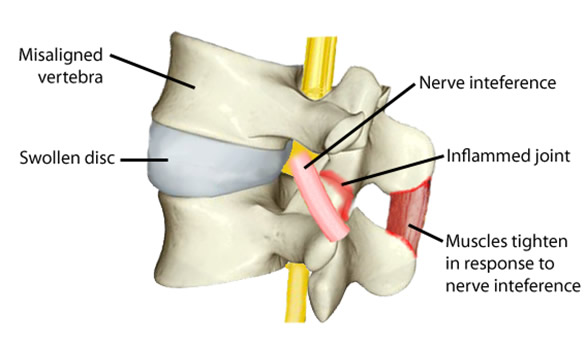How small misalignments create big problems.
Were you surprised at the extent of spinal instability or damage identified on your examination? Most people are. A Subluxation is when spinal bones become misaligned and squeeze the spinal nerves which cause impairment. The simplicity of the subluxation, however, belies the fact that there is quite a complex process taking place underneath the surface. Many people wonder how they could have so many subluxations and never even know it, especially in the absence of any obvious accident or injury. For starters, most of the nerve roots that branch off the spinal column don’t cause any pain or outward symptoms. Instead, they are motor nerves that run your organs, give power to your muscles, rebuild cells, etc. Think of them like the wires running from your circuit panel to your television or refrigerator. When a bone shifts onto a nerve, just like flipping a switch, it shuts down the power to its organ or body part. Since there are far more motor nerves affected than pain receptors, most subluxations initially occur without your knowledge, and in fact, can be quite long lived before any symptoms surface. Secondly, subluxations more often result from the culmination of routine daily activities than from one catastrophic accident or event Posture, lifting, sitting day in and day out and working on computers all day cause damaging shifts in your spine without In other words, subluxations can result from the stresses of normal daily living without you realizing it. Finally, when symptoms do occur, they usually creep up on us rather than become full blown all at once. When symptoms slowly escalate over a long period, the body has time to adapt. So what might be regarded as severe pain had it come on suddenly can seem moderate or even mild in comparison when it slowly ramps up in intensity. The end result, however, is no less devastating to your spine and your health. When most people think of a subluxation and a pinched spinal nerve, they envision immediate symptoms such as sharp, shooting pain, burning, or numbness. But as you can see, while these sensations certainly do result from subluxations, usually they take some time to express themselves. Since subluxations can go undetected under the surface for months or years at a time, the moral of the story is to have your spine checked for subluxations long before symptoms become apparent. The only way to know for sure whether or not you have subluxations is by getting a chiropractic check-up. If you know someone who has not had their spine examined, regardless of whether or not they are exhibiting symptoms or have pain, please send them in for a chiropractic evaluation. Let’s get them the help they need before their pot comes to a boil.



